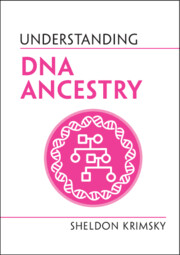Book contents
- Understanding DNA Ancestry
- Series page
- Understanding DNA Ancestry
- Copyright page
- Reviews
- Dedication
- Contents
- Foreword
- Acknowledgments
- 1 Introduction
- 2 The Business of DNA Ancestry
- 3 What Our Genomes Tell Us about the Geographical Origins and Movements of Early Human Populations
- 4 The Science behind DNA Ancestry Testing
- 5 Ancestry Informative Markers
- 6 Ancestry DNA Population Reference Panels
- 7 Comparing a Donor’s DNA to Reference Panel Populations
- 8 Probing Your DNA
- 9 Forensic Applications of Ancestry DNA Results
- 10 Privacy, Personal Identity, and Legal Issues
- 11 Discovering Unknown, Missing, or Mistaken Relatives
- 12 Accuracy, Consistency, and Validation of DNA Ancestry Tests
- 13 Conclusion
- Summary of Common Misunderstandings
- References
- Index
- Other books authored, coauthored, or coedited by Sheldon Krimsky
1 - Introduction
Published online by Cambridge University Press: 05 March 2022
- Understanding DNA Ancestry
- Series page
- Understanding DNA Ancestry
- Copyright page
- Reviews
- Dedication
- Contents
- Foreword
- Acknowledgments
- 1 Introduction
- 2 The Business of DNA Ancestry
- 3 What Our Genomes Tell Us about the Geographical Origins and Movements of Early Human Populations
- 4 The Science behind DNA Ancestry Testing
- 5 Ancestry Informative Markers
- 6 Ancestry DNA Population Reference Panels
- 7 Comparing a Donor’s DNA to Reference Panel Populations
- 8 Probing Your DNA
- 9 Forensic Applications of Ancestry DNA Results
- 10 Privacy, Personal Identity, and Legal Issues
- 11 Discovering Unknown, Missing, or Mistaken Relatives
- 12 Accuracy, Consistency, and Validation of DNA Ancestry Tests
- 13 Conclusion
- Summary of Common Misunderstandings
- References
- Index
- Other books authored, coauthored, or coedited by Sheldon Krimsky
Summary
Stories of family deceits and deceptions have become commonplace in a media receptive to personal tales of triumph and tragedy. A distinguished geneticist learns in his mature years that his mother, while married to his legal father, had a secret affair that begat him. A best-selling author discovers that her paternal DNA was from a medical student serving as a sperm donor and not her legal father, who traced her ancestry deep into Eastern Europe. A woman who, as a newborn, was left in a bag abandoned in the foyer of a Brooklyn apartment building searches for her biological parents 23 years later. These revelations are the result of the millennial DNA ancestry revolution.
Keywords
- Type
- Chapter
- Information
- Understanding DNA Ancestry , pp. 1 - 7Publisher: Cambridge University PressPrint publication year: 2021

